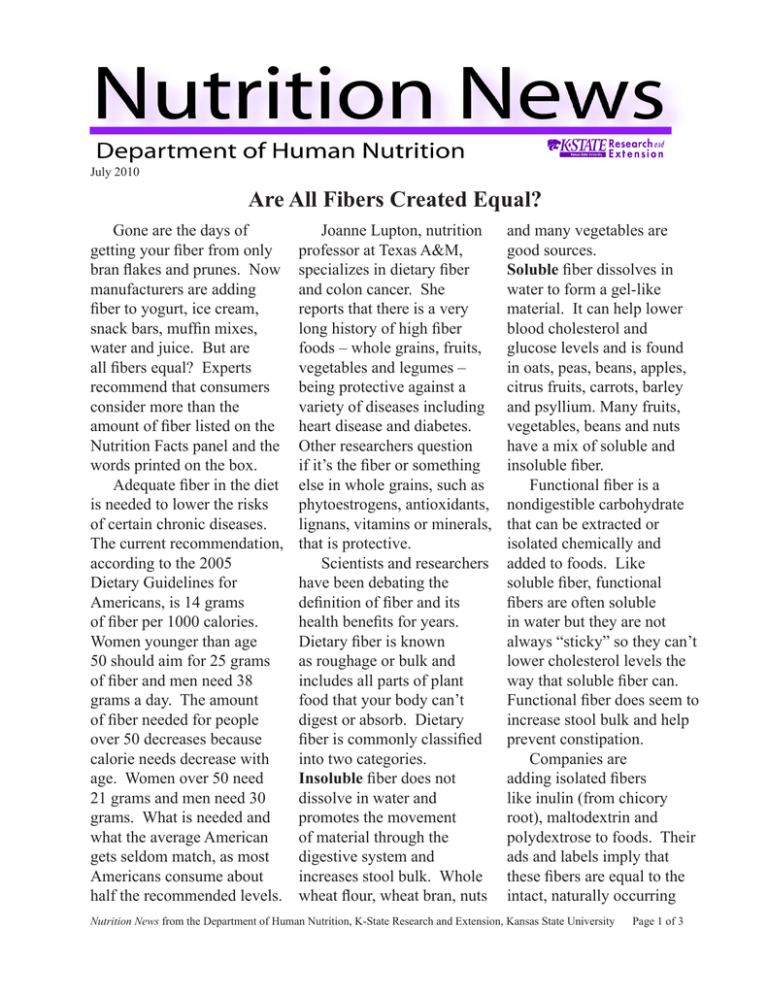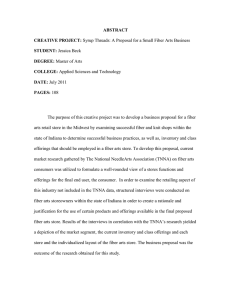Gone are the days of Joanne Lupton, nutrition and many vegetables are
advertisement

July 2010 Are All Fibers Created Equal? Gone are the days of getting your fiber from only bran flakes and prunes. Now manufacturers are adding fiber to yogurt, ice cream, snack bars, muffin mixes, water and juice. But are all fibers equal? Experts recommend that consumers consider more than the amount of fiber listed on the Nutrition Facts panel and the words printed on the box. Adequate fiber in the diet is needed to lower the risks of certain chronic diseases. The current recommendation, according to the 2005 Dietary Guidelines for Americans, is 14 grams of fiber per 1000 calories. Women younger than age 50 should aim for 25 grams of fiber and men need 38 grams a day. The amount of fiber needed for people over 50 decreases because calorie needs decrease with age. Women over 50 need 21 grams and men need 30 grams. What is needed and what the average American gets seldom match, as most Americans consume about half the recommended levels. Joanne Lupton, nutrition professor at Texas A&M, specializes in dietary fiber and colon cancer. She reports that there is a very long history of high fiber foods – whole grains, fruits, vegetables and legumes – being protective against a variety of diseases including heart disease and diabetes. Other researchers question if it’s the fiber or something else in whole grains, such as phytoestrogens, antioxidants, lignans, vitamins or minerals, that is protective. Scientists and researchers have been debating the definition of fiber and its health benefits for years. Dietary fiber is known as roughage or bulk and includes all parts of plant food that your body can’t digest or absorb. Dietary fiber is commonly classified into two categories. Insoluble fiber does not dissolve in water and promotes the movement of material through the digestive system and increases stool bulk. Whole wheat flour, wheat bran, nuts and many vegetables are good sources. Soluble fiber dissolves in water to form a gel-like material. It can help lower blood cholesterol and glucose levels and is found in oats, peas, beans, apples, citrus fruits, carrots, barley and psyllium. Many fruits, vegetables, beans and nuts have a mix of soluble and insoluble fiber. Functional fiber is a nondigestible carbohydrate that can be extracted or isolated chemically and added to foods. Like soluble fiber, functional fibers are often soluble in water but they are not always “sticky” so they can’t lower cholesterol levels the way that soluble fiber can. Functional fiber does seem to increase stool bulk and help prevent constipation. Companies are adding isolated fibers like inulin (from chicory root), maltodextrin and polydextrose to foods. Their ads and labels imply that these fibers are equal to the intact, naturally occurring Nutrition News from the Department of Human Nutrition, K-State Research and Extension, Kansas State University Page 1 of 3 Nutrition News from the Department of Human Nutrition, K-State Research and Extension, Kansas State University fiber in foods, but there is not much research to support this. The American Dietetic Association (ADA) maintains that fiber found in natural foods is superior to added or functional fiber. More studies must be done to fully determine the difference. There are many differences among isolated fibers, but they all look the same on the foods’ Nutrition Facts panel, which tells you the total grams of dietary fiber in a serving of packaged food. To find out whether that fiber is from intact fiber or isolated fiber, look at the ingredients list located right below the Nutrition Facts panel on the food packaging. The most common isolate fibers used are maltodextrin, inulin, polydextrose, oat fiber, resistant starch, pectin and gum. Consumers are typically unaware that this added fiber does not have all the benefits of natural fiber. “If you eat five fiberfortified yogurts a day, you can meet your fiber goal. But that’s not the message we want the people to know. It’s not the same as getting 25 grams of fiber from a variety of fruits, vegetables and whole grains,” said Joanne Slavin, who served on the National Academy of Sciences Panel on the Definition of Dietary Fiber. “It is all about making good choices so that the foods you eat are a good source of fiber.” Fiber-fortified foods and snacks lack the healthy chemicals present in plant foods. Researchers are not sure whether it is the fiber or the combination of nutrients in plant foods that make them good for you. Professor Lupton advises people to think about the food as well as its fiber content. She stresses that if fiber is put into a food that is high in calories, fat or sodium, it may be a poor choice and a waste of calories. About 100 new foods with added fiber hit U.S. grocery shelves annually, according to Page 2 of 3 Mintel, a leading market research company. Food manufacturers like polydextrose because it has only one calorie per gram, versus sugar’s four calories, yet it takes up as much volume as sugar. It counts as a fiber on food labels because it is not broken down by human digestive enzymes. The Food and Drug Administration requires any food with more than 15 grams of polydextrose per serving to warn consumers that “sensitive individuals may experience a laxative effect from excessive consumption of this product.” Eating foods with isolated fiber won’t hurt you, but eating naturally fiber-rich foods is recommended because they contain a mix of different fibers as well as important vitamins, minerals and phytochemicals. Variety and moderation count in all things! The following chart lists the fiber content of several foods that are naturally rich in fiber. Nutrition News from the Department of Human Nutrition, K-State Research and Extension, Kansas State University Food Fruits Raspberries or blackberries Raisins Apple or orange Serving Size Fiber (grams) 1 cup 1 cup 1 8 5.4 4 Vegetables (cooked) Artichokes Spinach Peas 1 cup 1 cup ½ cup 14.4 7 5 Legumes, Nuts and Seeds Black beans or split peas (cooked) Lentils Almonds 1 cup 1 cup 24 16.3 15.6 4 Grains, Cereal, Pasta Bulgur (cooked) Pasta, whole wheat Oatmeal Brown rice 1 cup 1 cup 1 cup 1 cup 8.2 6.3 4 3.5 Page 3 of 3 Source: U.S. Department of Agriculture National Nutrient Database References: Nutrition Action. Center for Science in the Public Interest. Fiber Free for All. 7/09. Bonnie Liebman; Family Safety and Health. Chew on This: Does It Matter Where You Get Your Fiber? Spring 2010. For more information about healthy eating, contact your local extension office. The Food Assistance Program can help people of all ages with low income buy nutritious foods for a better diet. To find out more, call toll-free 1-888-369-4777. Contents of this publication may be freely reproduced for educational purposes. All other rights reserved. In each case, credit Kathy Walsten, BS, Nutrition Educator, Family Nutrition Program, Department of Human Nutrition; Kansas State University; Are All Fibers Created Equal?, July 2010. K-State Research and Extension is a short name for the Kansas State University Agricultural Experiment Station and Cooperative Extension Service, a program designed to generate and distribute useful knowledge for the well-being of Kansans. Supported by county, state, federal and private funds, the program has county Extension offices, experiment fields, area Extension offices and regional research centers statewide. Its headquarters is on the K-State campus, Manhattan. Brand names appearing in this publication are for product identification purposes only. No endorsement is intended, nor is criticism implied of similar products not mentioned. Kansas State University Agricultural Experiment Station and Cooperative Extension Service, Manhattan, Kansas. Kansas State University is an equal opportunity provider and employer. Kansas State University, County Extension Councils, Extension Districts, and the U.S. Department of Agriculture cooperating.






